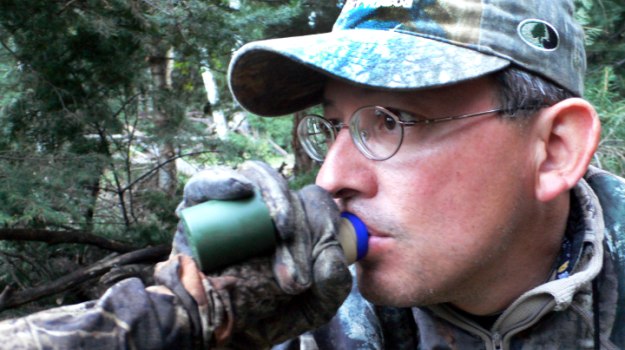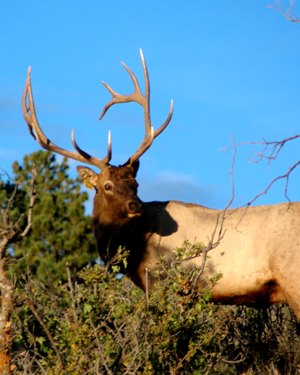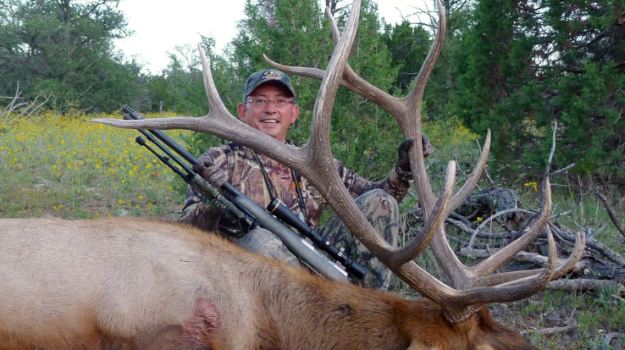
Editor’s Note: Ralph Ramos of Las Cruces, New Mexico, guides elk hunters in New Mexico, as well as teaches seminars on how to call elk. He’s been guiding elk hunters for more than 20 years, mainly in the Gila National Forest and the Lincoln National Forest. He’s been wearing Mossy Oak camouflage for 25 years, and his favorite pattern is Infinity. “This pattern has a lot of brown in it and blends in really well with the foliage and terrain where I hunt,” Ramos says. “I’ve been shooting PSE bows for 15 years. I’d been on several elk hunts with Pete Shepley the creator of PSE, and Pete introduced me to the people at Mossy Oak. Then I met Tim Anderson of Mossy Oak at one of the Rocky Mountain Elk Foundation (RMEF) national conventions in Reno, Nevada, when he attended my elk seminar. Since then, I’ve been an official Mossy Oak Pro. But I was wearing Mossy Oak long before I met Tim.
I really like to hunt the bulls in their bedding zones. Once I know where the bulls are bedded, I use loud cow calls to try to stimulate a bull to bugle and give up his location. If I don’t get a response, I’ll give one or two bugles. I carry two different bugle tubes with me. Then I can simulate the sound of two different bulls. I’ll start calling in two different directions to sound like two satellite bulls arguing with each other. Even if a bull doesn’t respond with a bugle, often, we can hear him chuckle.
Once the bull has told us where he is, I use a Montana decoy to hide behind as my hunter and I move toward the bull. This way, the bull can see what he believes is the cow that the other two bulls have discussed. Often, when we’re moving toward the bull that we want to take, we’ll spook another elk. The elk we spook may be cows that are bedded a little farther out from the bull, or they may be young bulls. If we have the decoy in front of us and start giving some cow calls, then even if the bull stands-up or looks and spots the decoy, he’s not as likely to spook and run off. I like to get with 150 yards of the bull and then set-up the Montana decoy. The bull already has heard us calling and walking. When the bull sees the decoy, this confirms to him that the sounds he’s heard have been made by a cow elk, and he’s much more likely to come to you.
 In the seminars I teach, I explain a system called the X-Zone. I like to place the hunter in the middle of the X. I’ll put the decoy about 30-yards behind the hunter. I also take a stand about 75-yards behind the hunter. I’ll start using cow calls, bugles and any type elk call I can to get the bull to come to the hunter. When the elk is bugling, chuckling and grunting, he’s much like a turkey gobbler in the spring. He’s trying to call the cow to him. Since I don’t go to the bull, like a cow normally will, the bull will get somewhat nervous and try to get downwind of my hunter by either going left or right. If the bull is coming in to the left of my hunter, because the bull can’t see me, I’ll shift over to my right. I’ll call some more to attempt to pull that bull right into my hunter’s lap. I try and keep the hunter between me and the bull. While I’m moving, I continue to call to sound like a cow elk changing her position. I also switch calls to sound like several different cows and calves calling to each other. If the bull moves 100-200 yards to the right of my hunter, but still out of range, I’ll move back to my left and continue calling, sounding like calves and cows. If the bull starts coming toward my hunter, I’ll back out, putting more distance between me and the hunter to make the bull think that this little herd of calves and cows is leaving the area.
In the seminars I teach, I explain a system called the X-Zone. I like to place the hunter in the middle of the X. I’ll put the decoy about 30-yards behind the hunter. I also take a stand about 75-yards behind the hunter. I’ll start using cow calls, bugles and any type elk call I can to get the bull to come to the hunter. When the elk is bugling, chuckling and grunting, he’s much like a turkey gobbler in the spring. He’s trying to call the cow to him. Since I don’t go to the bull, like a cow normally will, the bull will get somewhat nervous and try to get downwind of my hunter by either going left or right. If the bull is coming in to the left of my hunter, because the bull can’t see me, I’ll shift over to my right. I’ll call some more to attempt to pull that bull right into my hunter’s lap. I try and keep the hunter between me and the bull. While I’m moving, I continue to call to sound like a cow elk changing her position. I also switch calls to sound like several different cows and calves calling to each other. If the bull moves 100-200 yards to the right of my hunter, but still out of range, I’ll move back to my left and continue calling, sounding like calves and cows. If the bull starts coming toward my hunter, I’ll back out, putting more distance between me and the hunter to make the bull think that this little herd of calves and cows is leaving the area.
Often, a bull will hang up maybe at 60-80 yards and just refuse to come any farther. He’ll bugle, growl and chuckle, trying to get that herd of cows and calves to come to him. He’s much like an ole turkey gobbler that hangs-up and won’t come into the call. When I hear that bull bugle one, two or three times from the same spot, I change calls to sound like a young bull and follow-up that young bull’s bugle with cow calls. Once that dominant bull hears that young bull’s bugle, I want him to think, “Now, I understand why those cows won’t come to me. They’ve got a young bull with them. I’m going over there and whip up on that young bull.” This is when the herd bull will start growling, chuckling and coming. I’ll give another spike bull bugle, and then generally the bull will be in front of my hunter.
These are some of the techniques I teach in seminars for Mossy Oak at the Bass Pro Shops Fall Hunting Classics and at the RMEF’s shows and meetings.
Ralph Ramos - the Bad News and the Good News for Elk Hunting in 2014



























